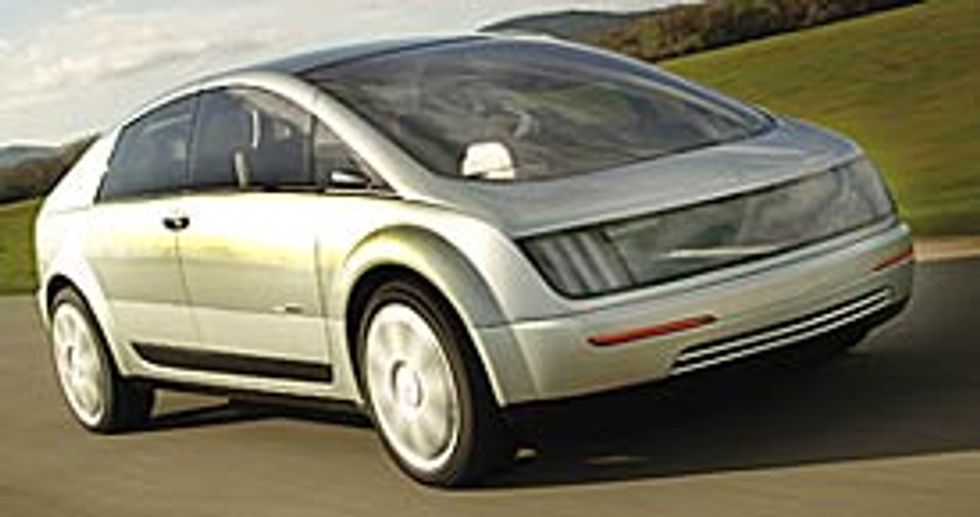There also must have been lots of cheering in the executive suite of General Motors Corp., where officials are committed to spending over US $1 billion by 2010 to get hydrogen fuel-cell vehicles ready for production. GM calls the effort Hy-wire, referring to hydrogen fuel and drive-by-wire technology. The company has told the world that its goal is to sell more than a million such cars annually just a few years after the 2010 introduction.
It is a bold strategy for both the actor-turned-politician and GM, whose most notable association until now has involved the Hummer, the gas-guzzling überwagen that Schwarzenegger drives and GM manufactures. And so far, so good: Schwarzenegger won his bid for the governor's office; now all that he and GM have to do is deliver on that clean-air promise. And that is going to be a lot tougher than enchanting California voters with the idea of clean cars, blue skies, and fresh air.
Hardly anyone disagrees that the fuel-cell vehicle is the future of the automobile industry, but it may not happen as fast as GM anticipates. "The industry feels that the fuel cell is inevitable," says Dan Sperling, director of the Institute of Transportation Studies at the University of California, Davis. "The question is how and when."
GM's Hy-Wire
Goal: Make a hydrogen fuel-cell vehicle commercially viable by 2010, and put a car on the market
Why it's a Loser: Success depends on the development of an infrastructure, which is out of the company's hands. And others may get to market first
Organization: General Motors Corp.
Center of Activity: Warren, Mich., with ancillary activities in Honeoye Falls, N.Y., and Mainz-Kastel, Germany
Number of People on Project: Nearly 500
Budget: Over US $1 billion
Two major classes of problems must be solved before fuel cells succeed in passenger cars. The lesser of the two involves problems with the fuel cells themselves; they are short-lived and fragile and cannot tolerate subfreezing temperatures when not running. The other surrounds what are called "infrastructure" issues related to the manufacture and distribution of the hydrogen fuel that powers the cells. Here the solutions are not obvious. The hydrogen fuel must be produced, either by reforming natural gas or petroleum or by using electricity to break down water into hydrogen and oxygen. And then the hydrogen must be made available to drivers to power their cars. In the most likely scenario, some number of gas stations would have to be retrofitted to dispense hydrogen; estimates for California alone range from 500 to 2400 stations, at a cost of $250 000 to $1.16 million each.
Even if the technology evolves quickly and the infrastructure follows suit, the odds may still be stacked against GM because there are other players at the table.
"There are other companies doing fuel-cell vehicles, at least as energetically as GM," says Sperling, although they are less vocal in promoting their efforts. The companies include DaimlerChrysler, Ford, Honda, Hyundai, and Toyota. Of those, Toyota appears to be the odds-on favorite, based on its success with hybrid vehicles that combine an electric motor with a gasoline-powered engine. Sperling indicates that the hybrid vehicle is "exactly the building block needed to launch fuel cells."
GM, meanwhile, has yet to put a full hybrid-electric vehicle on the market. The company doesn't see this lag as relevant to its efforts in fuel cells. Chris Borroni-Bird, director of the Hy-wire and AUTOnomy programs at GM, told IEEE Spectrum that, although putting a fuel cell into a conventional vehicle can be done more easily and quickly, that route doesn't allow the designers to take full advantage of a fuel cell's performance. The path GM is taking, designing a fuel-cell car from the ground up in its AUTOnomy program, Borroni-Bird says, "has a higher risk but more potential benefits."
Still, is there even a point to working on a fuel-cell vehicle now?
"If you really care about a national solution to our energy security and global warming problems, focusing on hydrogen fuel cells in the near term is a distraction, not a solution," says Roland Hwang, senior policy analyst for the Natural Resources Defense Council. By his analysis, investing in hybrids and other fuel-economy technologies today could lead to a U.S.-wide average in automobile efficiency of 55 miles per gallon by 2020, based on the realistic replacement rate of cars. A focus on fuel-cell development will lead, at best, to 100 000 fuel-cell vehicles sold in 2010, and 2.5 million in 2020. With those numbers, Hwang says, the fuel-economy approach saves oil over the fuel-cell method by a factor of 25.
So why is GM making this billion-dollar bet? Borroni-Bird is a true believer. "Because we are investing in this technology, we will have a chance to create a much better vehicle, protect the environment, and be a leader in the future," he says. But Hwang's analysis is harsh.
"It is clearly being used as a way to undermine political momentum to raise fuel economy standards." He sees the company as using its investment in fuel cells to build corporate image, not real cars.
